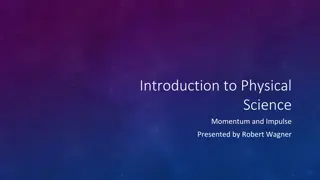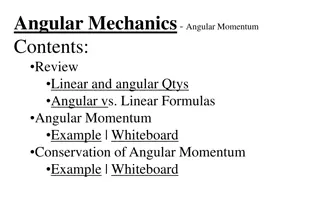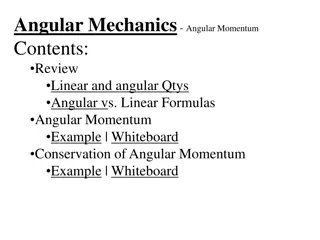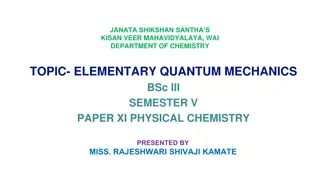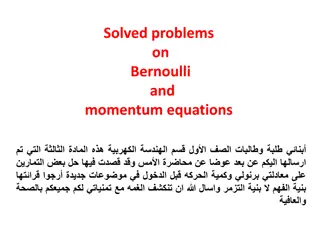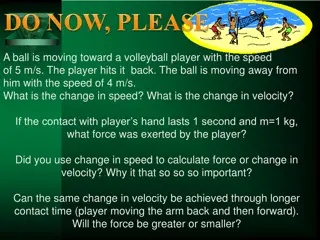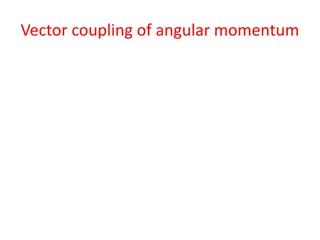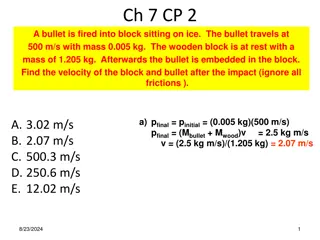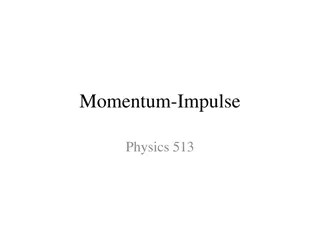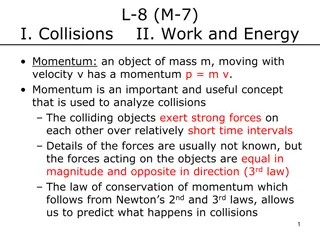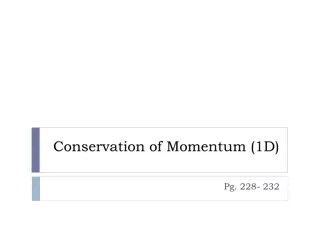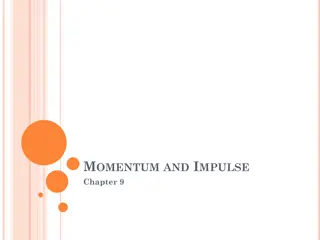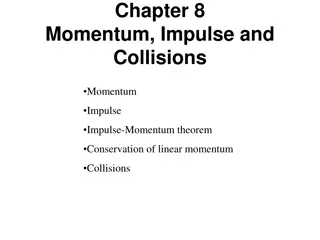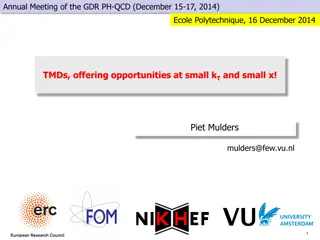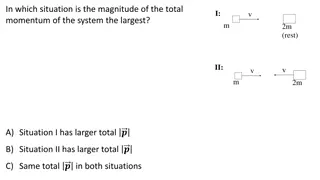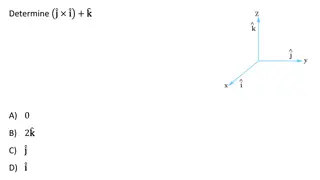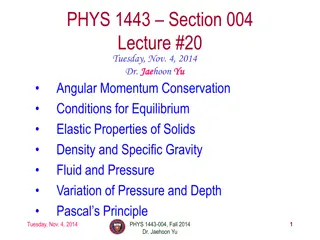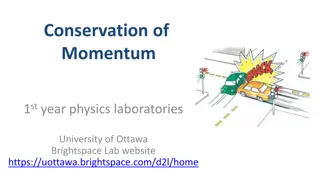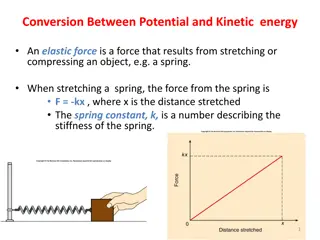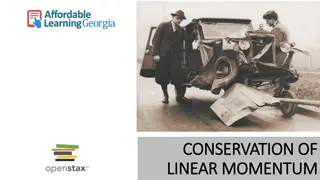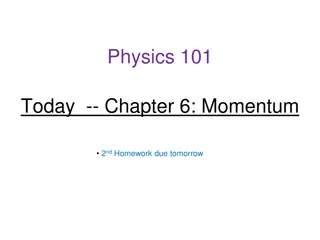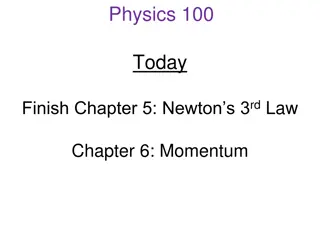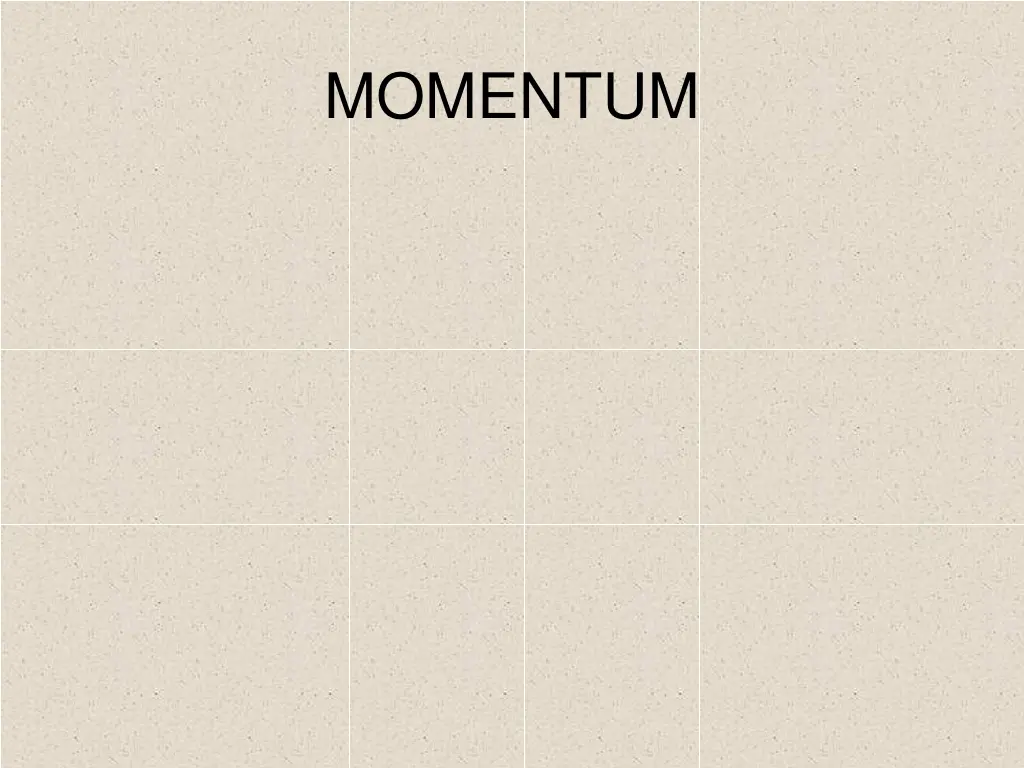
Understanding Momentum in Physics
Explore the concept of momentum in physics, including its calculation, relationship with mass and velocity, conservation principles, and real-world applications. Enhance your knowledge of forces, motion, and Newton's third law through practical examples and calculations.
Download Presentation

Please find below an Image/Link to download the presentation.
The content on the website is provided AS IS for your information and personal use only. It may not be sold, licensed, or shared on other websites without obtaining consent from the author. If you encounter any issues during the download, it is possible that the publisher has removed the file from their server.
You are allowed to download the files provided on this website for personal or commercial use, subject to the condition that they are used lawfully. All files are the property of their respective owners.
The content on the website is provided AS IS for your information and personal use only. It may not be sold, licensed, or shared on other websites without obtaining consent from the author.
E N D
Presentation Transcript
Specification Forces and motion Forces, movement, shape and momentum know and use the relationship: momentum = mass velocity p = m v use the ideas of momentum to explain safety features use the conservation of momentum to calculate the mass, velocity or momentum of objects use the relationship: force = change in momentum / time taken demonstrate an understanding of Newton s third law
Momentum (p) momentum = mass x velocity p = m x v mass is measured in kilograms (kg) velocity is measured in metres per second (m/s) momentum is measured in: kilogram metres per second (kg m/s)
Momentum has both magnitude and direction. Its direction is the same as the velocity. The greater the mass of a rugby player the greater is his momentum
Question 1 Calculate the momentum of a rugby player, mass 120kg moving at 3m/s. p = m x v = 120kg x 3m/s momentum = 360 kg m/s
Question 2 Calculate the mass of a car that when moving at 25m/s has a momentum of 20 000 kg m/s.
Question 2 Calculate the mass of a car that when moving at 25m/s has a momentum of 20 000 kg m/s. p = m x v becomes:m = p v = 20000 kg m/s 25 m/s mass = 800 kg
Complete Complete momentum mass velocity kg m/s 50 kg 3 m/s 160 kg m/s kg 20 m/s 1500 kg m/s 250 kg m/s kg m/s 500 g 8 m/s 3 kg m/s kgkg 50 cm/s
Complete Answers momentum mass velocity 150 kg m/s 50 kg 3 m/s 160 kg m/s kg 20 m/s 8 1500 kg m/s 250 kg m/s 6 kg m/s 500 g 8 m/s 4 3 kg m/s kgkg 6 50 cm/s
Force and momentum A force will cause the velocity of an object to change and therefore also its momentum. The greater the force the faster the momentum changes.
Momentum, acceleration and force Consider a body of mass m changing velocity from u to v in time t. acceleration = velocity change time taken a = (v u) / t Multiply both sides of this equation by the mass, m gives: ma = m (v u) / t ma = (mv mu) / t ma is equal to the force, F causing the acceleration. and (mv mu) is equal to the momentum change And so: F = (mv mu) t
momentum change force = time taken for the change force is measured in newtons (N) change in momentum is measured in: kilogram metres per second (kg m/s) time is measured in seconds (s)
Question 1 Calculate the force required to change the momentum of a car by 24000 kgm/s over a 6 second period. force = momentum change time taken = 24000 kgm/s 6 s force = 4000N
Question 2 Calculate the time taken for a force of 6000N to cause the momentum of truck to change by 42000 kgm/s.
Question 2 Calculate the time taken for a force of 6000N to cause the momentum of truck to change by 42000 kgm/s. force = momentum change time taken becomes: time taken = momentum change force = 42000 kgm/s 6000 N force = 7 seconds
Momentum conservation Momentum is conserved in any collision or explosion provided no external forces act on the colliding or exploding bodies. The initial momentum of the yellow car has been conserved and transferred to the red car
Question 1 A truck of mass 0.5kg moving at 1.2m/s collides and remains attached to another, initially stationary truck of mass 1.5kg. Calculate the common velocity of the trucks after the collision.
total momentum before collision p = m x v 0.5 kg truck: = 0.5 kg x 1.2 m/s = 0.6 kg m/s 1.5 kg truck: = 1.5 kg x 0 m/s = 0 kg m/s total initial momentum = 0.6 kg m/s Momentum is conserved in the collision so total momentum after collision = 0.6 kg m/s total momentum = total mass x velocity 0.6 kg m/s = 2.0 kg x v 0.6 2.0 = v common velocity = 0.3 m/s
Question 2 A train wagon of mass 800 kg moving at 4 m/s collides and remains attached to another wagon of mass 1200 kg that is moving in the same direction at 2 m/s. Calculate the common velocity of the wagons after the collision.
total momentum before collision p = m x v 800 kg wagon: = 800 kg x 4 m/s = 3200 kg m/s 1200 kg truck: = 1200 kg x 2 m/s = 2400 kg m/s total initial momentum = 5600 kg m/s Momentum is conserved in the collision so total momentum after collision = 5600 kg m/s total momentum = total mass x velocity 5600 kg m/s = 2000 kg x v 5600 2000 = v common velocity = 2.8 m/s
Head-on collisions In this case bodies are moving in opposite directions. Momentum has direction. One direction is treated as positive, the other as negative. In calculations the velocity of one of the colliding bodies must be entered as a NEGATIVE number. DIRECTION OF MOTION NEGATIVE POSITIVE + ve velocity - ve velocity
Question 1 A car of mass 1000 kg moving at 20 m/s makes a head-on collision with a lorry of mass 2000 kg moving at 16 m/s. Calculate their common velocity after the collision if they remain attached to each other. lorry, mass 2000kg car, mass 1000kg 20 m/s 16 m/s DIRECTION OF MOTION NEGATIVE POSITIVE
total momentum before collision p = m x v car: = 1000 kg x +20 m/s = +20000 kg m/s lorry: = 2000 kg x -16 m/s = -32000 kg m/s total initial momentum = -12000 kg m/s Momentum is conserved in the collision so total momentum after collision = -12000 kg m/s total momentum = total mass x velocity -12000 kg m/s = 3000 kg x v -12000 3000 = v common velocity = - 4 m/s The lorry/car combination will move in the original direction of the lorry.
Question 2 A car of mass 1000 kg moving at 30 m/s makes a head-on collision with a lorry of mass 2000 kg moving at 15 m/s. Calculate their common velocity after the collision if they remain attached to each other. lorry, mass 2000kg car, mass 1000kg 30 m/s 15 m/s DIRECTION OF MOTION NEGATIVE POSITIVE
total momentum before collision p = m x v car: = 1000 kg x +30 m/s = +30000 kg m/s lorry: = 2000 kg x -15 m/s = -30000 kg m/s total initial momentum = 0 kg m/s Momentum is conserved in the collision so total momentum after collision = 0 kg m/s The lorry/car combination will not move after the collision.
Explosions Before an explosion the total momentum is zero. As momentum is conserved, the total momentum afterwards must also be zero. This means that the different parts of the exploding body must move off in different directions.
Question 1 An artillery gun of mass 1500kg fires a shell of mass 20kg at a velocity of 150m/s. Calculate the recoil velocity of the gun. artillery gun, mass 1500kg 150 m/s shell, mass 20kg recoil
The total momentum before and after the explosion is ZERO p = m x v shell: = 20 kg x +150 m/s = +3000 kg m/s This must cancel the momentum of the gun. Therefore the gun s momentum must be -3000 kg m/s gun: = 1500 kg x recoil velocity = -3000 kg m/s recoil velocity = - 3000 1500 = - 2m/s The gun will recoil (move to the left) with a velocity of 2 m/s.
Question 2 A girl of mass 60kg throws a boy, mass 90kg out off a swimming pool at a velocity of 2m/s. What is the girl s recoil velocity? boy, mass 90kg boy, mass 90kg girl, mass 60kg girl, mass 60kg 2 m/s 2 m/s recoil recoil DIRECTION OF MOTION NEGATIVE POSITIVE
The total momentum before and after throwing the boy is ZERO p = m x v boy: = 90 kg x +2 m/s = +180 kg m/s This must cancel the momentum of the girl. Therefore the girl s momentum must be -180 kg m/s gun: = 60 kg x recoil velocity = -180 kg m/s recoil velocity = - 180 60 = - 3m/s The girl will recoil (move to the left) with a velocity of 3 m/s.
Crumple zones, air bags and a collapsible steering wheel are designed to increase the time taken for a driver or passenger to change momentum to zero during a crash. The equation: force = momentum change time taken shows that if the time taken is increased for the same momentum change the force exerted is decreased so is the injury to the driver or passenger.
Playground flooring question The picture shows rubber tiles used for playground flooring. Explain how these can reduce injury to children. ANSWER: When a child falls to the floor its momentum changes from a high value to zero. The rubber flooring tiles increase the time taken for this change. force = change in momentum time taken for the change Therefore the force on the child is reduced and so is the potential injury.
Newtons 3rd law of motion Newton s 3rd law of motion states that forces always occur in pairs. Each force has the same size but acts in opposite directions. The law is often expressed as: To every action there is an equal and opposite reaction Example1: The boy and girl are exerting equal and opposite forces on each other
Example 2: Rocket in flight There are a pair of forces: A = THRUST of the ROCKET ENGINES DOWNWARDS on the EJECTED GASES B = CONTACT push of the EJECTED GASES UPWARDS on the ROCKET ENGINES
Example 3: Tyre-road friction A car is able to move forwards due to friction acting between its tyres and the road. The force of friction of the road on the tyre acts in the forward direction and is equal but in the opposite direction to the force of friction of the tyre on the road.
Choose appropriate words to fill in the gaps below: A _____ is a push or a pull. A force can cause an object to ___________ or change shape. Force is measured in _______ (N) with a newtonmeter. There are many types of force. ________ force occurs when two bodies touch each other. Forces always occur in ______. If a force is exerted on an ________ there will always be another force, ______ in size, acting in the opposite ________. WORD SELECTION: newtons direction accelerate equal pairs force contact object
Choose appropriate words to fill in the gaps below: A _____ is a push or a pull. A force can cause an object to ___________ or change shape. accelerate force Force is measured in _______ (N) with a newtonmeter. newtons There are many types of force. ________ force occurs when two bodies touch each other. contact Forces always occur in ______. If a force is exerted on an ________ there will always be another force, ______ in size, acting in the opposite ________. direction pairs object equal WORD SELECTION: newtons direction accelerate equal pairs force contact object

